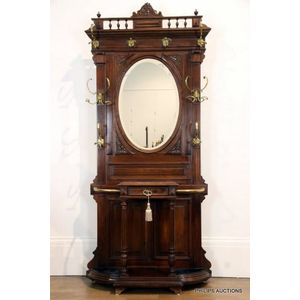Walnut Henri II Style Hall Stand with Marble Top
A walnut Henri II style hall stand, circa 1900, with a balustrade style pediment with a carved crest and urn finials, the rectangular back with eighteen brass hooks to eight fittings around an oval bevelled glass and relief carved floral spandrels and fluted pilasters with ionic capitals, a marble topped small drawer below raised on fluted and turned supports to a demi-lune base with twin metal lined umbrella stands, height 217 cm, width 98 cm, depth 31 cm
You must be a subscriber, and be logged in to view price and dealer details.
Subscribe Now to view actual auction price for this item
When you subscribe, you have the option of setting the currency in which to display prices to $Au, $US, $NZ or Stg.
This item has been sold, and the description, image and price are for reference purposes only.
- Fluting - A form of decoration found on many pieces of furniture, as well as ceramics, silver and clocks, in which round-bottomed grooves, of varying width and depth, are let into columns, pilasters, legs. As a general rule, flutes are cut in the vertical, though they may follow a turned leg in a spiral pattern. In cross-section, they may be described as a series of 'U' shapes, rising and narrowing at each end of the groove. Fluting is the opposite of reeding, with which fluting is often associated.
- Pilasters - In furniture a pilaster is a flattened column-like detail
applied to furniture. It is similar to a pilaster in architecture, but it is
typically smaller and less ornate. Pilasters are often used to decorate the
fronts of bookcases, cabinets, and other pieces of furniture. Pilasters can be
made of wood, metal, or other materials. They can be fluted, carved, or plain.
Pilasters are often used to add a touch of elegance and sophistication to
furniture. - Bevel / Chamfer - In furniture making, a chamfered corner refers to a technique used to create a smooth, angled edge on the corner of a piece of furniture. This is typically done by cutting away a small portion of the corner at an angle, typically 45 degrees, creating a diagonal edge, rather than a sharp 90-degree angle. This technique can be used on various parts of a piece of furniture such as table legs, drawer fronts, or door frames. Chamfering can add visual interest to a piece and can help to soften the overall look of a piece of furniture. It is often used in conjunction with other techniques, such as rounding edges or using contrasting wood species to create a more elegant, sophisticated look. Chamfering is a simple way to add a touch of elegance to a piece of furniture and it is a common technique used by furniture makers.
- Turning - Any part of a piece of furniture that has been turned and shaped with chisels on a lathe. Turned sections include legs, columns, feet, finials, pedestals, stretchers, spindles etc. There have been many varieties and fashions over the centuries: baluster, melon, barley-sugar, bobbin, cotton-reel, rope-twist, and so on. Split turning implies a turned section that has been cut in half lengthwise and applied to a cabinet front as a false decorative support.
- Circa - A Latin term meaning 'about', often used in the antique trade to give an approximate date for the piece, usually considered to be five years on either side of the circa year. Thus, circa 1900 means the piece was made about 1900, probably between 1895 and 1905. The expression is sometimes abbreviated to c.1900.
- Finial - An architectural decoration, found on the upper parts of of an object. On furniture they are usually found on pediments, canopies and shelf supports. On smaller ceramic or silver items, such as spoons, they may decorate the top of the item itself, or the lid or cover where they provide a useful handle for removal.
Finials have a variety of shapes and forms. They may be urn-shaped, baluster shaped round or spiral, but usually taper into an upper point. Many real life shapes may also be used as finials, such as pineapples, berries, pinecones, buds, lotus and acorns. Sometimes animals such as a lion are depicted, or fish and dolphins. - Pediment - The uppermost section of a tall usually double-heightened piece of cabinet furniture, surmounting the cornice. The pediment can take a variety of forms derived from the architecture of classical antiquity. A broken pediment is of triangular shape, however, the two raised sides do not meet at the apex but are 'broken' the gap between them often ornamented with an urn or finial. Swan-neck pediments are of similar form, although the uprights are gracefully arched, resembling a swan's neck. They are often found, for example, on longcase clocks.
This item has been included into following indexes:
